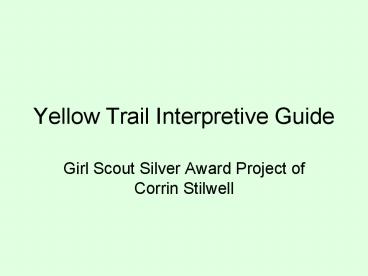Yellow Trail Interpretive Guide PowerPoint PPT Presentation
1 / 12
Title: Yellow Trail Interpretive Guide
1
Yellow Trail Interpretive Guide
- Girl Scout Silver Award Project of Corrin
Stilwell
2
1. Old Fox Den
- Foxes live in many different habitats and are
found all over the world. Wolves and humans are
predators of the fox. This den might have been
used to raise the kits (baby foxes) or it might
have been used as shelter during bad weather.
3
2. Skunk Cabbage
- Skunk cabbage grows in moist, swampy places. Its
bad odor which attracts bees, gnats, and flies
who pollinate this stinky plant. During the
winter, it makes enough heat to melt the snow
around it! But watch out! If you step on them,
they let off an even stronger smell.
4
3. Intermittent Stream
- This is a stream that will flow only during the
very wet periods of the year, like when the snow
melts and in the spring. During the summer, there
many not appear to be any water flowing, but
there is, right underneath the stream!
5
4. Homes for Many Creatures
- Trees like this are homes to a variety of
creatures like chipmunks, squirrels, insects, and
spiders. The holes like this provide shelter
during the rain and in the winter. Look around
the base of the tree. Do you see any evidence
that someone lives here?
6
5. Water Treatment Plant
- Behind you, and down this road is a water
treatment plant. Water treatment plants clean and
purify ground water and surface water so it can
be used by the public. They are essential to
keeping the public healthy and happy. You
wouldnt want to drink dirty water, would you?
7
6. Erosion
- Erosion is the wearing away of the Earths
surface. It can be caused by wind, rain, and
snow. Look at the sides of the creek. Does it
seem like the banks have been worn away? This is
erosion and can cause soil and other thing to
pollute the creek.
8
7. Animal Evidence
- All animals need water to live. Look around the
banks of the creek. Do you see any animal tracks?
These are animals coming to get drinks of water
and possibly something to eat.
9
8. Stream Life
- This stream is home to insects, spiders, frogs,
small fish, and many other animals. The presence
of these animals can tell you the health of the
stream. If there are many, the stream is healthy.
Look around and see what you can find.
10
9. Multiflora Rose
- The Multiflora Rose is a very invasive species of
plant. It can form dense thickets in open
woodlands like these. The plants were brought to
the United States from Japan during the 1860s to
form living livestock fences.
11
10. The Wetlands
- These wetlands are called scrub wetlands. This
means that they have only small trees and bushes
and are close to streams, creeks, or lakes. Many
creatures live in the wetlands like the
endangered bog turtles and even beavers!
12
11. Signs of Beaver
- A few years ago, this area was home to a family
of beavers. You can still see the evidence of
their presence by the rings around the trees.
Beavers chew off a ring of bark around the tree
to make it die and fall. They drag the fallen
tree to their dam which is further downstream.
Can you find any evidence that beaver use to live
here?

